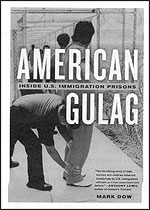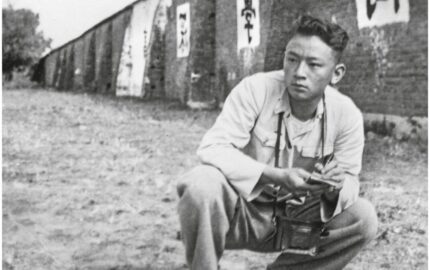
Editorial Cartoons: The Impact and Issues of an Evolving Craft
Many newspapers have decided not to hire a full-time editorial cartoonist, but instead publish the readily available work of syndicated cartoonists. To explore what impact these decisions and other changing circumstances related to editorial cartoons have on journalism, Nieman Reports asked cartoonists, editorial page editors, and close observers of cartooning to write out of their experiences and share their observations about how the long-time role that cartoons have played in journalism and democracy is being affected. – Melissa Ludtke, Editor

American Gulag: Inside U.S. Immigration Prisons
Mark Dow
University of California Press. 426 Pages. $27.50.Mark Dow’s compelling book is a voyage into the heart of darkness that is the United States’s immigration prison system. “American Gulag: Inside U.S. Immigration Prisons” reveals everything that the nation’s immigration authorities don’t want you to know about “a particular American prison system … with an astonishing lack of accountability, not only to outside criticism, but to the rest of government as well.” While much of what Dow documents happened under the watch of the former Immigration and Naturalization Service (INS), he makes a convincing case that the secrecy and abuses of immigrant inmates have only worsened since 9/11 and under the new Bureau of Immigration and Customs Enforcement, which is the Department of Homeland Security agency now in charge of locking up immigrants.
Dow’s interest in immigration prisons began at a place I know well. As a part-timer for Miami’s public school system in 1990, he taught a high-school equivalency course at the Krome detention facility, a notorious immigration prison on the edge of the Everglades. At the time, The Miami Herald had published stories written by Deborah Sontag (now of The New York Times) that exposed rampant sexual abuse of female inmates by Krome officers, among other ill treatment. Though immigration officials had denied Sontag access to Krome, she had gotten information from advocates, including another teacher who was quoted in the paper.
Before long, both that teacher and Dow were fired, but not before—as the book describes in the first chapter—they had to attend a meeting where a Krome officer explained “that the media tend to distort what they are told because their only goal is to sell papers.” So we can directly credit the Krome experience for inspiring this book.
Recently Dow recalled the epiphany he had while being fired by Krome’s of-ficer-in-charge. “While she was calmly tossing me out the door, pretending that everything was OK,” he told me, “I realized that these [INS] people felt untouchable. The only choice I had was not to go away.” That’s when he began writing freelance stories about immigration issues and collecting string for what years later became “American Gulag.”
Journalists and Immigration Coverage
National in scope, this exposé of institutional cruelty is a must-read for journalists covering immigration or living in immigrant-rich communities. I probably have interviewed about half of the sources and written about numerous cases that he cites. I was reassured that the same immigration officials who have lied to me also lied to him. The book is meticulously researched, with 66 pages of footnotes, and Dow weaves in immigration history and legal explanations. The abundance of facts proves his argument: that the lack of transparency and oversight has resulted in the systemic abuse of immigrants locked up from Seattle to Key West.
Certainly there’s plenty of ammunition for advocates who have been pushing for detention reforms for years. Yet it makes the case quietly. Rather than sermons or rants, Dow tells the stories of the systems’ victims—immigrants and jailers alike. Thus, he manages to humanize even the bureaucrats who run inhumane jails.
There’s outrage material here, too, particularly for those who agree with the Supreme Court’s recent decision that even U.S. terror suspects imprisoned on the Guantanamo Naval Base have a right to challenge their indefinite detention in federal court. “American Gulag” introduces dozens of immigrants who have been imprisoned indefinitely and mistreated on U.S. soil.
Some have committed no crimes. Asylum seeker Felix Oviawe from Nigeria, for example, was one of about two-dozen detainees subjected to a “beat and greet” reception upon arrival at the Union City Jail in 1995. What’s unusual here is that there was a criminal indictment and three jail officers were actually convicted. From legal documents and testimony, Dow relates how officers kicked, punched and plucked detainees’ body hair with pliers; detainees also were forced to put their heads in toilet bowls, to strip naked and stay in degrading positions while being encouraged to perform sexual acts upon each other. Sound familiar?
The book explores the big-money business that immigrant detention has become. Spurred by draconian 1996 laws, the boom in immigrant detention has profited local jails and private prison companies, such as Wackenhut Corporation. U.S. immigration authorities now imprison 200,000 people yearly, some 23,000 on any given day. For private contractors, the more and longer that immigrants are locked up, the better the revenue. The less spent on such frills as GED (General Education Development) classes, meals or medical care, the greater the profit.
Dow paints a nuanced tapestry of an “invisible” prison system and its pattern of deliberate abuse—from brutal to petty and capricious—designed to get detainees to leave the country voluntarily rather than fight detention. He details the endless transfers among facilities that distance detainees from their relatives and lawyers and stymie court proceedings; the retaliation against whistleblowers, be they inmates or immigration employees; the stealing of detainees’ money and property, and the medical abuses.
How can such institutional cruelty persist in the United States? In part, it’s the “legal fiction” that draws distinctions between the rights of U.S. citizens and everyone else. But it’s also the secrecy and lack of accountability that this immigration prison bureaucracy cultivates and protects. Whether in the old INS or new Department of Homeland Security, immigration authorities have raised misinformation to an art form. Dow dissects the use of dehumanizing terms such as “alien” and “illegals,” and euphemisms such as “detainees” and “detention center” for prisoners with limited recourse against the immigration jailers who also are judge and jury. “American Gulag” uncovers those lies for what they are.
Susana Barciela is a member of The Miami Herald’s editorial board. Portions of this review appeared earlier in The Miami Herald.


